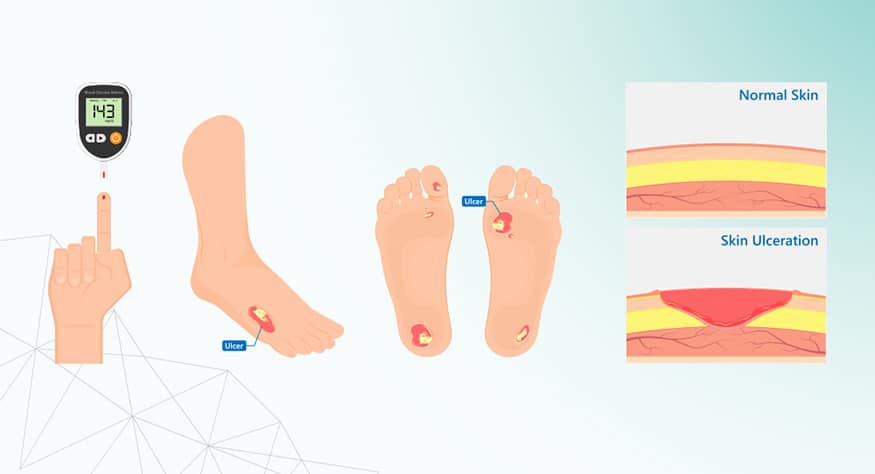

Prevalence
Diabetic foot ulcers (DFUs) occur in approximately 15% of patients with diabetes.1 Of those who develop a DFU, 6% will be hospitalized due to infection or other ulcer-related complication.1 DFU’s occur most frequently on the plantar aspect of the foot.

Risk Factors
Risk factors include age, duration of diabetes, poor glycemic control and diabetic nephropathy.2 Obesity, use of alcohol and tobacco may also play a role. Native Americans, African Americans, Hispanics, and older men are more likely to develop DFUs.3

Pathophysiology
There are a number of different factors that contribute to skin changes and breakdown. The major underlying cause for DFUs is peripheral neuropathy and ischemia from peripheral vascular disease.4

Assessment
The Wagner grading system is the most commonly used to classify severity.
- Wagner I: partial or full thickness not down to any underlying structure
- Wagner II: The ulcer extends down to deeper structure
- Wagner III: The ulcer extends into deep tissues such as the joint with abscess, infection and or osteomyelitis
- Wagner IV: localized gangrene in the foot
- Wagner V: extensive gangrene in the foot

Prevention and Treatment
Routine screening for patient at high risk of DFUs is an essential step for prevention. Regular foot examination, blood glucose management, smoking cessation, adherence to a diabetic diet, and patient education have been associated with significant reductions in ulcer development. Total contact casting (TCC) is the gold standard for offloading plantar diabetic foot ulcers.5 Contraindications to TCC include arterial insufficiency, infection, and highly exudative wounds.6 In patients who cannot tolerate a TCC, fixed ankle walker is acceptable.
References
- Hanley ME, Manna B. Hyperbaric, Diabetic Foot Ulcer. [Updated 2020 Jun 3]. In: StatPearls [Internet]. Treasure Island (FL): StatPearls; 2020 Jan-Available from:https://www.ncbi.nlm.nih.gov/books/NBK430783/
- Yazdanpanah L, Shahbazian H, Nazari I, et al. Incidence and Risk Factors of Diabetic Foot Ulcer: A Population-Based Diabetic Foot Cohort (ADFC Study)-Two-Year Follow-Up Study. Int J Endocrinol. 2018;2018:7631659. Published 2018 Mar 15. doi:10.1155/2018/7631659.
- McEwen LN, Ylitalo KR, Herman WH, Wrobel JS. Prevalence and risk factors for diabetes-related foot complications in Translating Research Into Action for Diabetes (TRIAD). J Diabetes Complications. 2013;27(6):588-592. doi:10.1016/j.jdiacomp.2013.08.003.
- Noor S, Zubair M, Ahmad J. Diabetic foot ulcer–A review on pathophysiology, classification and microbial etiology. Diabetes Metab Syndr. 2015;9(3):192-199. doi:10.1016/j.dsx.2015.04.007.
- Liden B. Total Contact Cast System to Heal Diabetic Foot Ulcers. Surg Technol Int. 2017; 30:71-76.
- Chakraborty PP, Ray S, Biswas D, et al. A comparative study between total contact cast and pressure-relieving ankle foot orthosis in diabetic neuropathic foot ulcers. J Diabetes Sci Technol. 2015;9(2):302-308. doi:10.1177/1932296814560788
